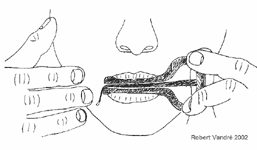Jaw Harp Know-how Pages & How to play Jaw Harps
On this page we tried to arrange helpful and comprehensive information about Jew's Harps and Jew's Harp playing. We wish you lots of fun browsing through, discovering, being astonished and trying out what you read here.
If you have any questions about Jew's Harps which are not answered here, please contact us and we will try our best to answer your inquiry satisfyingly.
Content
What is a Jew's Harp?
The origins of the Jaw Harp
Jaw Harp traditions today
Types of Jaw Harps
Playing Instructions: "How to play the Jew's Harp in a Virtuoso Manner" by Robert Vandré (extract)
Protecting Your Teeth
Jaw Harp Care
The 1.000 names of the Jew's Harp
What is a Jaw Harp?
The Jaw Harp is an ancient musical instrument, which is widely spread on the entire Eurasian continent, but in some other regions of our planet, too. The sounds of the Jaw Harp come from its reed when it vibrates through its frame which is attached at your slightly opened teeth or lips. The Jaw Harp's reed or tongue vibrates into your mouth where the sounds are being resonated and where it is possible to modulate the sound further by changing the size of the mouths cavity. Doing so it is possible to modulate many overtones/harmonics out of the keynote (which is the frequency its reed vibrates) of the Jaw Harp. Applying various plucking and breathing techniques you can create many sound and rhythmic effects with the Jaw Harp.
The origins of the Jaw Harp
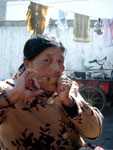
The question of the origins of the Jew's Harp is very difficult to answer as it is most likely that many ancient models and variants were made of bamboo or wood and have long perished.
It is generally assumed, however, that Jew's Harps originated in South-East Asia or Oceania, where archetypal variants made of bamboo are played to this day.
The oldest findings of Jew´s Harps in Europe were made in Rouen (France) in 1868: The five bronze Jew´s Harps date back to the fifth to seventh century AD.
According to a plausible hypothesis the Jew´s Harp came into existance probably only after the most recent ice age 10.000 years ago when the Bering Street didn´t serve as a land bridge anymore. If the Jew´s Harp had existed already before, it most probably would have spread together with the migration from Asia towards America. But the Jew´s Harp is mostly unknown to the indigenous people of America.
Jew´s Harps were and still are mostly widespread in Asia and Europe, whereas they serve different cultural functions. For instance the Jew´s harp is used in shamanic rituals (e.g. in Siberia) or for matchmaking purposes (e.g. in Vietnam and Europe). It serves as a simple playing instrument for children and shepherds (e.g. in Europe and Japan), as a rythm instrument (e.g. in the classical Indian music) and, rarely, also as a melody instrument: e.g. during the European Classical period the Austrian Johann Georg Albrechtsberger wrote some concerti for strings and Jew´s Harp.
Jaw Harp traditions today

What Jaw Harps can offer today probably can be illustrated easily by taking a look at our huge collection of Jew´s Harp CDs with numerous sound samples or by browsing through the online video portals, for instance YouTube searching for "Jew´s Harp" or "Dan Moi".
Europe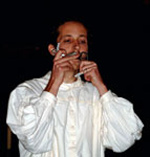
In Germany the Jew´s Harp tradition is in danger of becoming extinct. There are only few manufacturers and one rarely finds the instrument in German folkloremusic. Unlike Germany the Jew´s Harp is much more present in Austria. Maybe the little instruments gains more attention there because Austria is the country with the highest Jew´s Harps production worldwide.
Also in Scandinavia and Sicily one can find a vital and unfractured Jew´s Harp folklore tradition. Whereas the Scandinavian folklore appears to be rather quiet, slow and melodic, the Sicilian folklore sounds rather intensive, loud and fast.
In other regions in Europe, e.g. in Galicia, Estonia or Hungary, committed Jew´s Harp smiths and folklore musicians try to reactivate their nearly lost Jew´s Harp tradtion
Asia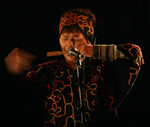
In Central Asia and Sibiria the Jew´s Harp is together with the frame drum still one of the most important shamanic instruments. In India, Mongolia and in parts of China and in Southeast Asia Jew´s Harps are deeply-rooted in the classical music tradition and folklore in many regions. Often small ethnic groups keep the Jew´s Harp tradition as part of their traditional life style vivid, for example as part of certain ceremonies (matchmaking e.g.).
America
The Jew´s Harp found its way to America as simple instrument of the settlers and was integrated into their folklore music. The aboriginal people of America on the other hand played the mouth bows, an advancement of the bows used for hunting, which rely on similar principles to produce tones and sounds as the Jew´s Harp.
Africa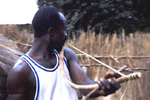
In several parts of the African continent ancient Jew's Harps have been excavated. Today the Jaw Harp does not play any role in African classical music and folklore. But instead of this there is a widespread and old tradition of playing mouthbows in many areas in Africa.
World Music
World Music is a romping place of exotic and rare musical instruments from many cultures. Because the Jew's Harp is basically easy to learn and it's great variety of incredible effects, this tiny instrument is being used more and more in world music and world fusion ensembles on stage. Quite often Jew's Harps can be heard together with didgeridoos and percussion instruments. Many young bands start to discover the great rhythmic and sound effects potential of the Jew's Harp.
Types of Jaw Harps
Bow-shaped and lamellate Jew's Harps (Teeth- and Lips Jew's Harps)
The most common types of Jew's Harps are the Bow-shaped or Teeth Jew's Harp and the Lamellate or Lips Jew's Harp.
Both trump types are being hold with the same hand and plucked with the other hand. The Bow-shaped Jew's Harp is plucked at the reed, the Lamellate one at the end of the frame. The reed vibrates, producing the fundamental note always heard during playing.

The Bow-shaped Jew's Harps have to be held against the teeth, but not the Lamellate ones. Why is that so?
The answer holds some basic information about the functioning of Jew's Harps in general: On Bow-shaped Jew's Harps the reed is attached to a frame made of a forged metal stick. The stick is bowed so that its ends run parallel and very close to the reed. To play, the frame is held near the base of the reed, and the reed is plucked at its tip.
Lamellate Jew's Harps can have different shapes. They are made from one piece of wood or metal (mostly brass), into which the reed is cut. In most cases the frame encloses the reed. The player holds the frame on the side of the reed tip and plucks the frame on the side of the reed base.
Both types of Jew's Harps show only a narrow slit between frame and reed. The player's lips touch the frame and bring the sound of the vibrating reed in close contact with the oral cavity functioning as a resonance chamber.
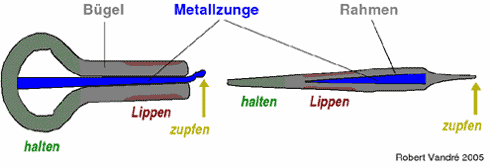
The reed can vibrate, because the connection to the frame is a spring. This spring is - so to speak - the hinge between frame and reed. As the reed vibrates, so does the frame - the reason is physics: Action equals reaction - every action has an equal and opposite reaction.

The Bow-shaped Jew's Harp has to be held against the teeth to make the head function as a balance weight and absorb the vibration of the frame. Otherwise, the soft lips, touching the frame just where it vibrates, will muffle the joined movement and sound of frame and reed. Without teeth the Jew's Harp sound has no reverberation.
The Lamellate Jew's Harp on the right functions different: The frame vibrates not where the lips are, but where it is held by the hand. The hand functions as balance weight, and without teeth the sound is not muffled by the lips.
Thus, contrary to a common statement, the teeth do not connect the sound of the Jew's Harp to the skull of the player to produce resonance. The skull functions as a mere balance weight. The lips are responsible for the sound connection, and it is the cavities of head, throat and chest that function as resonance chambers. This we learn from the Lamellate Jew's Harps that have a clear and strong sound without direct connection to teeth and skull.
Pluck and Knock Jew's Harps
Pluck and Knock Jew's Harps are variations of the Lamellate/Lips Jew's Harp. The difference of both is the way they are being plucked.
Pluck Jew's Harps are equipped with a string at the same place where "normal" Lips Jew's Harps are usually are being picked with the finger. Plucking softly but peppy and elastically (in most cases in an angle of about 20° to the front away from the Jew's Harps direction) the reed is put into vibration. This type of Jew's Harp is especially popular in Southeast Asia, but it can be found in Central and East Asian cultures, like in Kyrgyzstan and North Japan, too. Due to the higher physical effort plucking this Jew's Harp, playing it seems always to be a dance.

Knock Jew's Harps are very rare. We only know this type from Bali (Philippines). This Jew's Harp type has a a small block (anvil) of the same material (bamboo) at the same end where "normal" Lips Jew's Harps are being plucked. This anvil needs to be knocked softly from the side in order to make the reed vibrate.
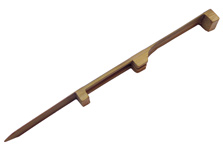
Playing Instructions: "How to play the Jew's Harp in a Virtuoso Manner" by Robert Vandré (edited extract)
Introduction
It is easy to play the Jew's Harp. You put the instrument against your mouth and just start playing. Many sounds and effects are easily found by giving it a try. I like playing the Jew's Harp very much and have learned playing by self-study - presumably like most players. There are few instructions on how to play, and most of them do not teach more than how to hold the instrument and pluck the reed. Well - actually more is not necessary for a start.
However, if you want to play music, that is, shape sounds and tunes on the Jew's Harp intentionally, you need to know playing techniques and the functioning of the instrument. These instructions seek to contribute to this knowledge: They describe and illustrate a variety of playing techniques and give some background information on the instrument. For each technique a sound example is provided.
The Jew's Harp is a rhythm as well as a melody instrument. The instructions in the main part of this paper describe playing techniques: How can different tunes and sounds be produced, and by what means can rhythmic patterns be expressed (articulation)?
After the section on playing techniques I added an article on the physical origin of the Jew's Harp sound and its tone row: Being an instrument with a natural harmonic row, each Jew's Harp is provided with specific tones. Which tones can be produced by a single Jew's Harp? This is a theoretical subject, but it is worth some thought: The natural harmonic row can be heard from your harp, and if you want to play other notes, you are going against the physics of your instrument.
Playing Techniques
There is no such thing as a single and universally accepted playing technique for the Jew's Harp. Therefore the techniques described below are suggestions meant to be altered and improved just as you like. The Figures and sound examples present Bow-shaped Jew's Harps, but the techniques described are valid for all Jew's Harps.
How to hold the Jew's Harp
Put the Jew's Harp against the slightly opened lips with one hand in such a way, that the reed can swing through them. Bow-shaped Jew's Harps have to touch the opened incisors, too. The end of the frame (Lamellate Jew's Harps) or the reed (Bow-shaped ones) is plucked with the fingers of the other hand. It produces the fundamental note (or prime tone) of the instrument that is heard continuously while playing. The oral cavity and other resonance chambers amplify different overtones of this fundamental note, thus producing the tone colours and pitches of your playing. There are numerous ways of holding and plucking the Jew's Harp.
Plucking
By plucking the reed the fingers play separated tones, producing tone lengths and rhythm. The reed may be plucked by one stretched finger, picking the reed from below and away from the mouth. The finger may also pick the reed in the opposite direction. Most Bow-shaped/Teeth Jew's Harp do even have a better sound when picking into the mouth's directino. Plucked back and forth, melodies with fast rhythm patterns can be played, as in sound sample 1. .
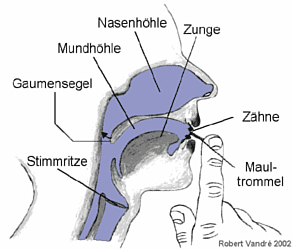
Repetition, Triple Fingers
If the palm of the plucking hand is turned towards the mouth and the upper arm is hold horizontal, elbow at shoulder height, than forefinger, middle-finger and ring-finger can pick the reed alternately and in quick succession, somewhat alike the way a flamenco-guitar-player works the guitar strings. The effect can be heard in sound sample 2. This technique needs a lot of practice before the plucking gets regular and the reed is prevented from hitting the frame of the Jew's Harp. To keep the hand still and only the fingers moving, the thumb may support the hand on the cheek bone.
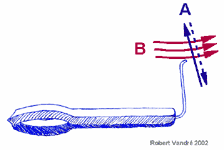
Articulation by breathing
Beyond holding the frame and plucking the reed, almost everything in playing the Jew's Harp happens inside your mouth and throat, or is done by the diaphragm, by breathing: Separated, articulated tones can be produced by short breaths. When breathing in and out, the air stream amplifies the fundamental note. In sound sample 3 the Jew's Harp is plucked regularly. By breathing rasping sounds are produced between the plucks.
Articulation with your tongue
A succession of tones can be "pronounced" by your tongue, like articulation on the recorder or flute. When playing the recorder, the tongue interrupts the air stream. With the Jew's Harp, no air stream is needed. In this case the tongue opens and closes the oral cavity, allowing and interrupting resonance. With or without an air stream, the technique is very similar. For slow melodies I suggest to open and close the cavity with the tongue just behind the upper incisors, like pronouncing de de de. For quick successions of tones you may pronounce doodle doodle doodle, using a swinging move of the tongue on the palate. However, flute players use de ge de ge deg. In sound sample 4 the harp is again plucked regularly. In between the plucks articulation is done by expressing de de de, doodle doodle doodle and doodle de doodle de doodle. This technique is easy and can be played very fast. Nevertheless it is rarely heard on Jew's Harp recordings.
Pitches and how to play melodies
On the Jew's Harp different pitches are produced mostly by movements of the tongue, altering the shape and size of the resonance chamber, mostly the oral cavity. The movements of tongue and mouth are the same as when pronouncing the different vowels, producing pitches from deep to high in the order e - a - i - o - u. This is difficult to describe - just try it. .
In this way tunes can be played using the overtones of the fundamental note provided by the Jew's Harp reed (see below, natural harmonic row).
At the higher part of the row the overtones are so near each other that practically every melody can be played irrespective of the fundamental note. In the lower part of the row the distance between the overtones is more pronounced and not every note can be played.
As the fundamental note is heard all the time, a melody played with the overtones will sound best if the fundamental note fits in. For example, a Jew's Harp tuned C (that is, C is the fundamental note) will be good to play melodies on the C major (as well as minor) key. The basic tone is reminiscent of the drone of bagpipes and medieval stringed instruments, as illustrated in a section of La Quarte Estampie Real.
To play sheet music, you have to recognize the melody, since unlike on a piano, the notes of a melody can not be produced mechanically. The playing of melodies functions like whistling or singing: They are formed freely inside the mouth/throat.
How to play Teeth Jew's Harp without contact to the teeth
To spare your teeth, I recommend to attach the harps to a piece of wood (shown left) or a piece of metal tube (shown in the center). Fixed to an object of some weight, the Jew's Harp can be played without contact to the teeth. You just have to put the frame against your lips. The sound is almost the same as normal, without weight and putting the harp against your teeth (only the player himself/herself will hear the sound differently, as it is transported to the ears via the skull when using the teeth). There are several advantages: Playing without the harp touching the teeth is very comfortable, especially when playing or practicing a lot. Playing without touching the teeth enables rapid change between several harps. And the holding hand is able to relax. At DAN MOI you can buy such Jew's Harp handle made of wood in two different sizes. (figure right)
I tried to play something like this on Bougie [Bougie in musical notation] on three Jaw Harps.
A good sound without teeth is achieved by a weight of 200 to 300 g that is 20 to 30 cm long. The size is essential for the functioning of the weight: The reed vibrates in a rotating manner (center, blue arrow). The weight has to function as a lever-arm against the rotation (red arrow).
The metal tube shown in Figure 7, right, is attached to the jew's harp by double laces. The laces go through the tube and are tied to a wooden pin. By turning the pin, the laces are twisted and tightened. The Wooden Jew's Harp handles from DAN MOI work in the same manner.
Sound Effects
Many playing techniques produce sound effects that influence both melody and rhythm. The number of possible sound effects may be unlimited. It is worth just to try out and discover ever new effects. Especially the tongue is a very talented organ. In the following some suggestions.
An interesting effect that can be used for articulation originates from the voice organ: The voice chink (glottis) is the opening that regulates the flow of air through the oral cords. When closed, the resonance is altered in such a way that in addition to the "normal" overtones, deeper overtones are amplified. Two overtones can be heard simultaneously and influenced independent of each other. To achieve this, the voice chink has to be closed. This is the same action that is used when talking to pronounce a single vowel: What? #I don't get this. At the # the chink is closed for an instant to pronounce the vowel "I". When coughing it is the voice chink that holds back and suddenly releases the breath. In sound sample 5 a melody is heard. Than the chink is closed and the additional tones of the altered resonance are heard. In the following section of the example the first melody is accompanied by these additional tones.
Nasal and oral cavity are important resonance chambers of the jew's harp. Movements in these cavities directly affect the sound of the harp. The nasal cavity can be closed against the resonace chambers of bronchial tubes and chest by the soft palate. It is this "closing" of the nose you may use if you talk and want to sound like you caught a cold. Also the oral cavity can be closed against the air-tube. This is done when speaking "ng" like in the suffix "-ing": Silently pronouncing "ing ing ing ing" while playing the Jew's Harp results in an interesting effect that is heard in the first part of sound sample 6.
The second part illustrates a tongue effect: The middle part of the tongue is put against the upper molar teeth, and the tip touches and leaves the palate - like speaking ne ne ne.
Two other effects performed outside the mouth. Firstly, the finger-capodastro: The reed of the jew's harp can be pinched between thumb and forefinger or middle finger of the hand holding the jew's harp frame. The basic tone is muted, and it gets a higher pitch, like in sound sample 7.
Secondly, the kiss: If you want to spare your teeth, you may hold the jew's harp against your pursed lips. The sound is muted. If the lips are closed, the reed claps against them. By parting the lips just after the clap you get the effect of sound sample 8.
Tone Generation and Tone Row of the Jew's Harp
Tone Generation
It is difficult to place the Jew's Harp in the system of musical instruments. On the one hand it is classified as plucked idiophone, together with the musical clocks: The plucked part of the instrument sounds itself.
On the other hand, the Jew's Harp belongs to the aerophones, together with the wind instruments and the instruments of the accordion type: In this class of instruments the sound is generated by a vibrating air column (flutes etc.) or by a stream of air stimulated to sound by a reed (harmonica, accordion). The similarity to accordion instruments becomes clear when Jew's Harps, held against the lips and teeth respectively, begin to sound without being plucked, just by breathing in or out. Clemens Voigt of DAN MOI told me how this effect works:
The reed has to be shifted a little from the level of the frame, and the air flow has to pull it back towards the frame level.

On Bow-shaped Jew's Harps the effect works if the reed is pushed gently at the basis by the thumb of the hand holding the frame to shift it a little. In this way the Jew's Harp works just like a harmonica. In sound sample 9 the tone G is heard, first played on an accordion, than on the Jew's Harp stimulated by breathing in, and finally plucked on the Jew's Harp.
As the sound of the Jew's Harp is formed in the same resonance chambers inside the head and chest as that of the voice, there is a strong similarity between Jew's Harp playing and overtone singing. In sound sample 10 I sing the tone G, changing the sound of the overtones just as in Jew's Harp playing by altering the oral cavity. Then I play the same sequence of tones on the Jew's Harp.
The Natural Harmonic Row
In our common tonal system the octave consists of 12 equal half-tone steps (enharmonic temperament). This means, that the number of vibrations per second (frequency, unit: Hz) of one tone multiplied with 1,059463 equals the frequency of the following half tone. If any frequency is multiplied again and again with this factor, after 12 steps the frequency is just doubled, and the respective tone is transposed in an octave above. Thus, as the frequency of successive half tones always is altered by the same factor, the absolute difference of the frequencies is less at deep tones (low frequencies) and higher at high tones (high frequencies).
The tone row of the Jew's Harp (as well as that of any instrument with a natural harmonic row) is different:
For example, the reed of the harp used in most sound examples has a fundamental frequency of about 98 Hz (tone G). This fundamental note can stimulate vibrations with frequencies of 2 times 98 Hz, 3 times 98 Hz, 4 times 98 Hz and so on.
The reason for this can be imagined as follows: The reed vibrates before the mouth, with the oral cavity as resonance chamber. Depending of the shape of the cavity, the air can vibrate with certain frequencies.
If one of these frequencies is a multiple of the reed vibration, e.g. 4 x 98 = 392 Hz, the air is stimulated and the respective tone is amplified. If the quotient of the two frequencies is, let's say, 3.5 instead of 4, the two vibrations are not in harmony and the reed will not stimulate the air in the cavity - the respective tone is not amplified. In physics, resonance means the amplification of two vibrations that are in harmony.
This means, that Jew's Harps can stimulate frequencies that are multiples of that of the fundamental note, that is, the Jew's Harp of the sound examples can play the multiplication tables from 98. These frequencies represent the overtones of the fundamental note, also called partials or harmonics. The next overtone (2nd harmonic) vibrates with 2 x 98 Hz, which means it is just one octave higher (tone g). The tones between 98 Hz (G) and 196 Hz (g) cannot be amplified. The next octave (tone g1) again has a doubled frequency, that is 4 x 98 (4th harmonic). Here we have one tone in between: 3 x 98 Hz = 294 Hz, which about corresponds to the tone d1 with an enharmonic frequency of 293,7 Hz (3rd harmonic). In the following octave until tone g2 (8 x 98 = 884 Hz) there are three steps of the multiplication tables of 98 corresponding to three tones that can be amplified. Thus, the higher we get in the scale, the more tones can be played with a natural harmonic row.
In soun sample 11 the Jew's Harp is plucked continuously, while the oral cavity is altered. The resonance of the 6 overtones from d1 to g2 can be heard.
Like the tone d1 in our example, the overtones in between the octaves of the fundamental note deviate from the tones of the enharmonic scale. The 11th harmonic, 11 x 98 Hz = 1078 Hz, is almost in the middle between c3 sharp (1047 Hz) and c3 flat (1109 Hz). These deviations are measured in hundredth of a half tone, the so called cent. The overtones of fundamental notes that are themselves tones of the enharmonic scale allways show the same pattern: For any fundamental note the 11th harmonic will diverge by 49 cent from the enharmonic scale. An overview of the natural harmonic rows is given in the overtone table (pdf)..
Range of the Jew's Harp
The resonance chambers of mouth and chest of the player can amplifie a certain range of frequencies, irrespective of the fundamental note of the Jew's Harp. This range of tones that can be played is certainly different for each individual player. In her monograph on the Jew's Harp, Regina Plate states that the pitches that can be played range from 500 to 2000 Hz, corresponding to two octaves. In my experience tones with a frequency of up to ca. 2300 Hz can be played. The altered resonance functioning at closed voice chink allows to play tones as deep as about 250 Hz. E.g., the tones heard in sound sample 11 range from 294 to 784 Hz.
On the basis of the fundamental note, the tones that can be played on a certain Jew's Harp can be looked up in the overtone table.
On Jew's Harps with a deeper fundamental note more different pitches can be played than on those with a higher fundamental note. E.g., the harp of sound sample 7 has the tone A1 with 55 Hz as fundamental note (without finger-capodastro), compared to 98 Hz in the other sound examples. With the multiplication tables from 55 you will get more steps between 250 and 2300 Hz than with those from 98 Hz.
Protecting Your Teeth
As already described by Robert Vandré in his section about the Jew's Harp handles, almost all Bow-shaped Jew's Harps are pressed against the teeth for playing. In this way, the player can stabilise the frame with the weight of their jaw so that the tongue can vibrate evenly.
However, there is no need to be afraid as this does not harm the teeth. Countless players prefer Bow-shaped Jew's Harps because of their full sound – and to our knowledge none of them ever cracked their front teeth because of playing Jew's Harp.
Nevertheless, playing Jew's Harps with very taut reeds over longer periods of time can be very tiring for the teeth.
Similarly, quickly changing between several Jew's Harps while playing, one after another, as for lead performance for example (a traditional way of playing in Austria and Germany), may cause less experienced or sensitive players toothaches.
However, there are simple ways of protecting your teeth:
The best solution is the use of a gumshield. Every dentist will be able to make one for you. The shield is made from duroplastic, and it is the kind usually made for children and adults to keep them from grinding their teeth at night. The shield is made from an impression cast of your teeth so that it will fit you exactly. You will need one for your upper and one for your lower front and canine teeth. You can leave out the molars, as this will make it easier for you to fit and remove the shield and make it more comfortable to wear. Gumshields are discreet, easy to handle and most effective – moreover, they do not have any negative influence on the sound and possibilities of playing the Jew's Harp!
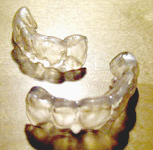
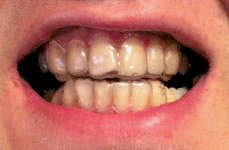
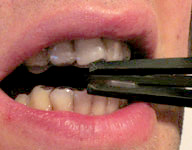
Another way of avoiding teeth contact is in stabilising the frame of the Jew's Harp with another object that functions as counter weight (see above). In this way, every Jew's Harp can be played by just placing the frame against your lips. However, fixing a weighty object to the frame reduces the possibilities of sound and effects.
Jew's Harp Care

First of all, it is very important that you always remember to wipe your Jew's Harp dry with a piece of cloth or tissue after playing. This will help you prevent corrosion of metal instruments, and it is an effective way of fighting the accumulation of residue between frame and tongue, both of which have a negative impact on the sound.
In addition, Jew's Harps that are particularly prone to corroding (e.g. blank steel) may be carefully treated with Vaseline or Ballistol oil after playing.
Vaseline is a common skin-care product on petroleum basis.
Ballistol oil is a pure vegetable oil originally developed for precision mechanics. It is known for its curative effects and some traditional healers prescribe it for internal use. It is even certified as dermatologically reconsible.
In short, Ballistol oil's unique features make it a preferred care product for Jew's Harps.

The 1000 Names of the Jew's Harp
The Jew's Harp accompanies mankind already for a very long time. Therefore this wonderful small instrument which has been used for so many purposes has got umpteen names in all cultures it appeared in. Some of the terms we assembled here to show you its diversity.
As a source of information we used the great brochure "The 1000 Names of the Jew's Harp" from the Cahier-series "The Thought Dispeller" written by Jew's Harp pioneer Phons Bakx, which is based on long-term music-ethnological research.
German (Germany, Austria, Switzerland)Maultrommel, Brummeisen, Trumme, Maulbrummel, Zaubereisen, Maulharfe, Mundharfe, Brummstahl, Kinnbackenharfe, Mundgeige, Maulgeige, Maulorgel, Mundharmonika, Maulharmonika, Maultrompe, Maultrompete, Drombe, Drumme, Trombula, Mundharmonika, Brumla, Crembalum, Muultrummle, Zupftrumml, Strohtrommel, Pilsentrommel, Schlüsseltrommel, Mentschafanga, Trümpi, Trumpel, Tromff, Trümmi, ...
Französischer Sprachraum (Frankreich, Belgien)Guimbarde, Rébute, Reberbe, Bombarde, Petite lyre, Trompe, Rebube, Jeu trompe, Rabube, Semsonia, Guidarro, Champagno, Tambour buccal, Épinette, Gronde, Gawe, Troemp, Trompken, ...
Dutch (Netherlands, Belgium)Mondharp, Mondtrom, Mondtrommel, Muyltromp, Moeltromje, Muiltrompje, Troemp, Jeugdtromp, Jeudy tromp, Snorreding, Bromijzer, Oink-beest, Gedachtenverdrijver, Speelke, Teuter, Speeltrompje, Boerentromp, ...
Skandinavia (Denmark, Norway, Sweden, Finland)Mundharpe, Mundgige, Munn harpa, Munnharpe, Munnhorpe, Munnhorpa, Mungigan, Mungigor, Giga, Huuliharppu, Huulipeli, Suuharppu, Munniharppu, Suurauta, Pussipeli, Hunnharpa, ...
English (Great Britain, USA, etc.)Jew's harp, Jaw harp, Jaw's harp, Juice harp, Horn, Irish harp, trump, Jewsaphone, Iewes harp, Jawes Harp, Jew's trump, Worry killer, Thought Dispeller, Gewgaw, Ributhe, Ribup, Rivupe, Trumb, Tromb, Devil's Trump, Twanger, Giddy row, Sturmant, Ystyrmant, Biwba, Biwbo, Giwga, Trumpa, ...
Latin, Spanish, PortugeseTrompa, Birimbao, Berimbao, Militô, Trompe, Marimbula, Marimbao, Zamponhe, Grambola, Sanfoina, Sansonia, Verimbao, Mosu-Gitarra, Guimbarda, Pio Pollo, ...
ItalySpassapensieri, Scacciapensieri, Zanfòrgna, Cinfòrgna, Zinfòrgna, Trombola, Crembalum, Cymbalum orale, Ribèba, Rebebbe, Arbebola, Brombola, Harmonica, Ciamporgna, Sampogne, Marranzanu, Maranzan, Marranzano, Marranzeta, Marauni, Mariolo, Maridu, Calarunni, Gnagnararrone, ...
HungaryDoromb, Drimba, Dorong, Dongó, ...
Baltics (Lithuania, Latvia, Estonia)Mynn harpa, Parmupill, Konnappill, Suupill, Lotsa-pill, Dambras, Bandurelis, Bandúrka, Zobasse, Vargas, Vargana, Wargana, ...
Slavic Languages in Eastern Europe and RussiaDombra, Brumbice, Drumbla, Drumla, Dromlja, Drumlica, Bzucak, Grumbla, Grumble, Grumle, Brumajzla, Brumle, Brumbla, Brumla, Dremla, Dromla, Bromble, Drombulja, Drmbolj, Drombulje, Brunda, Brukalica, Brukavica, Brumda, Drumelza, Dromlja, Drumeljce, Vargan, Wargan, Argan, Organ, Worgan, Zubanka, Truba, Khomus, Drymba, Kobza, Vigran, Vargane, Drimba, Drimb, Drind, Drâmbă, Dramboj, ...
Central Asian LanguagesQopuz, Zamburak, Agiz Tanburasi, Cang, Chang, Cheng, Tchang, Chang ko'uz, Qobiz, Morchang, Munchang, Moorchang, Murchang, Morchanga, Moursing, Morshingu, Morcha, Ghoraliyo, Ghodyun, Tendor, Tendohor, Yangroi, Vazang, Gagana, Gogona, Gonggina, Goúgina, Ka Mien, Jangroi, Yheku, Mazin, Tonda ramma, Kha-wang, Binaiyo, Binayo, Malingo, Tchangu, Reké, Machinga, Murjanga, Kha-rna, Srug-ma, Tsampa, Gon kap, Varkhan, Varám-túna, Warchan, Palnay, Kúpas, Temir komuz, Temir komouz, Kiguatch coz komouz, komus, zhygach ooz komuz, gopuz, kopys, shan-kobyz, Komyz, Kabys, Koubys, Kubiz, Kobus, Kubýz, Kumýz, Temir-kubýz, Zubánka, Umkrés, Koms, Qowuz, Qobus, Cang, Kavuz, Changi zanona, Kiquatch coz komous, Sheler khomus, Khomouss, Timir khomus, Komis, Túmra, Kunká, Bargán, Kamuti, Mukkuna, Moexkoena, Muhonyu, Quongon, Vychranga, Khozón, Kunkon, Konkikhi, Khungkái, Kunkan, Konkoy, Kingay, Panga, Kordavun, Kondyvkon, Pangár, Punggar, Yayar, Pymel, Aman khuur, Aman Tobshuur, Temür Khuur, Kuru, Zanboorak, ...
East and Southeast AsiaKoukin, Kohkin, Kuchibiwa, Kuchi no koto, Mukkuna, Mukkuri, Kannimukur, Kyakon, Biwabon, Biyabon, Koqin, Kouqin, Kou xian, Kuhuang, Kuqin, Helang, Long guh, Zhai, K'a kwuo-kwuo, Tuong, Tong, Pang teu ing, Kon hle, Rhnui, Nggoec, Goeh, Guat, Rab ncas, Ncaas, Toung, Goc, Dan moi, Röding, Hoon toeng, Ku-chin, Tiv-tiv, Datok, Tubu Sepatz, Lubu, Angkuoch, Ankuoc, Nvatt, Gougina, Gagana, Mago, Ata, Saga saga, Yangong, Toi, Genggong, Ginggong, Kha-rnga, Hodong-hodong, Popo, Gogo, Djouring, Juring, Karinding, Rinding, Karèng, Grinding, Stobung, Engsulu, Aping, Teruding, Kedang, Kobeng, Kombing, Nago besi, Karombi, Berimbak, Alibaw, Olat, Onat, Kulang, Barimbao, Kinaban, Barimbo, Afiw, Bikung, Guyud, Giwong, Ulibao, Kubing, Kumbing, Balingbao, Kolibao, Purivan, Agiweng, Kading, Koding, Subing, Oribao, Stobbrou, Bungkau, Rangun, ...
EsperantoBûsoharpo
